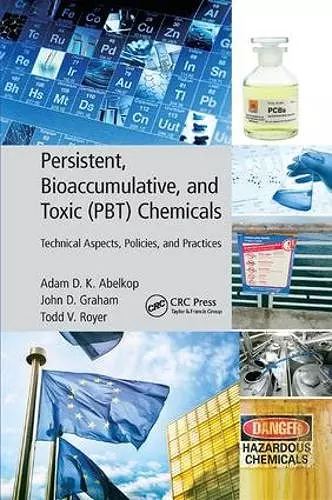Persistent, Bioaccumulative, and Toxic (PBT) Chemicals
Technical Aspects, Policies, and Practices
John D Graham author Adam D K Abelkop author Todd V Royer author
Format:Paperback
Publisher:Taylor & Francis Ltd
Published:26th Jul '17
Currently unavailable, and unfortunately no date known when it will be back
This paperback is available in another edition too:
- Hardback£130.00was £130.00(9781482298772)

Developed from the efforts of a multiyear, international project examining how persistent, bioaccumulative, and toxic (PBT) chemicals are evaluated and managed, Persistent, Bioaccumulative, and Toxic (PBT) Chemicals: Technical Aspects, Policies, and Practices focuses on improving the processes that govern PBTs. Incorporating science and policy literature—as well as interviews and panel discussions featuring experts from around the world—this book provides you with an international perspective of PBT policies (centering on Europe, Asia, and North America), and reveals major findings and recommendations for improving PBT science, laws, and policies.
It includes case studies of specific chemicals, provides an introduction to the overall subject of toxic chemicals, and weighs in on science and policy expansion for PBTs. It also provides summary tables of important PBTs, and discussions on the number of PBTs in commerce, weight of evidence approaches, market deselection, and international management.
The text:
- Assesses the history, current practice, and future of PBT management
- Considers the roles scientific data, modeling, and conventions play in identifying and regulating PBTs
- Explores the number of PBTs in commerce and the growing role of weight of evidence (WOE) in the making of PBT determinations
- Identifies issues that are likely to come up in WOE judgments
- Examines international, national, subnational, and regional PBT policies
- Includes a comprehensive and easy-to-understand analysis of PBT science and policy
This book reviews the current science, policies, and practices surrounding the regulation of PBTs. It also provides relevant research, recommendations, and suggestions for improving the management and oversight of PBTs.
"… an essential tool for policymakers and practitioners concerned with chemical management policy in the 21st century. It is the best available handbook explaining the history of PBT principles and the current state of regulatory approaches to the subject. It further provides a clear and comprehensive picture of the scientific and policy issues that warrant attention by all parties involved in chemical management matters."
—Mark Greenwood, Greenwood Environmental Counsel
"This text provides a comparative analysis of regulatory experience in considering persistence, bioaccumulation and associated toxicity in prioritization and risk assessment of industrial chemicals, based on input from a broad range of sources. As a result, it provides highly relevant and recommended background reading for those considering options to address the essential need to more efficiently prioritize, assess and manage much larger numbers of existing industrial chemicals."
—M.E. (Bette) Meek, Associate Director, Chemical Risk Assessment, McLaughlin Centre for Risk Science, Faculty of Medicine, University of Ottawa
"Many countries are increasingly concerned about pollution problems caused by chemicals that are "persistent, bioaccumulative, and toxic" (PBT). Despite international alarm about these chemicals, there is little unanimity about how to regulate or identify them. This book by Abelkop, Graham, and Royer (all, Indiana Univ.) explores the various definitions, methods of analysis, and regulatory policies currently used in the effort to minimize the damage that PBT chemicals may cause. The situation is complicated because different nations analyze and regulate these compounds differently, and there may even be important differences within the subdivisions of individual countries. For example, China, which has become a major chemical producer, has far fewer well-developed policies than the US or the European Union, and some US states have local regulations that differ from national standards. In order to reconcile these various requirements, it will first be necessary to identify how they differ. This book is a valuable step in that direction. It is is well written and thorough but provides a level of detail that will be most useful to advanced-level students and professionals. Thus, it is mainly recommended for libraries that support graduate programs in environmental studies"
—CHOICE, June 2016
ISBN: 9781138792944
Dimensions: unknown
Weight: 453g
303 pages